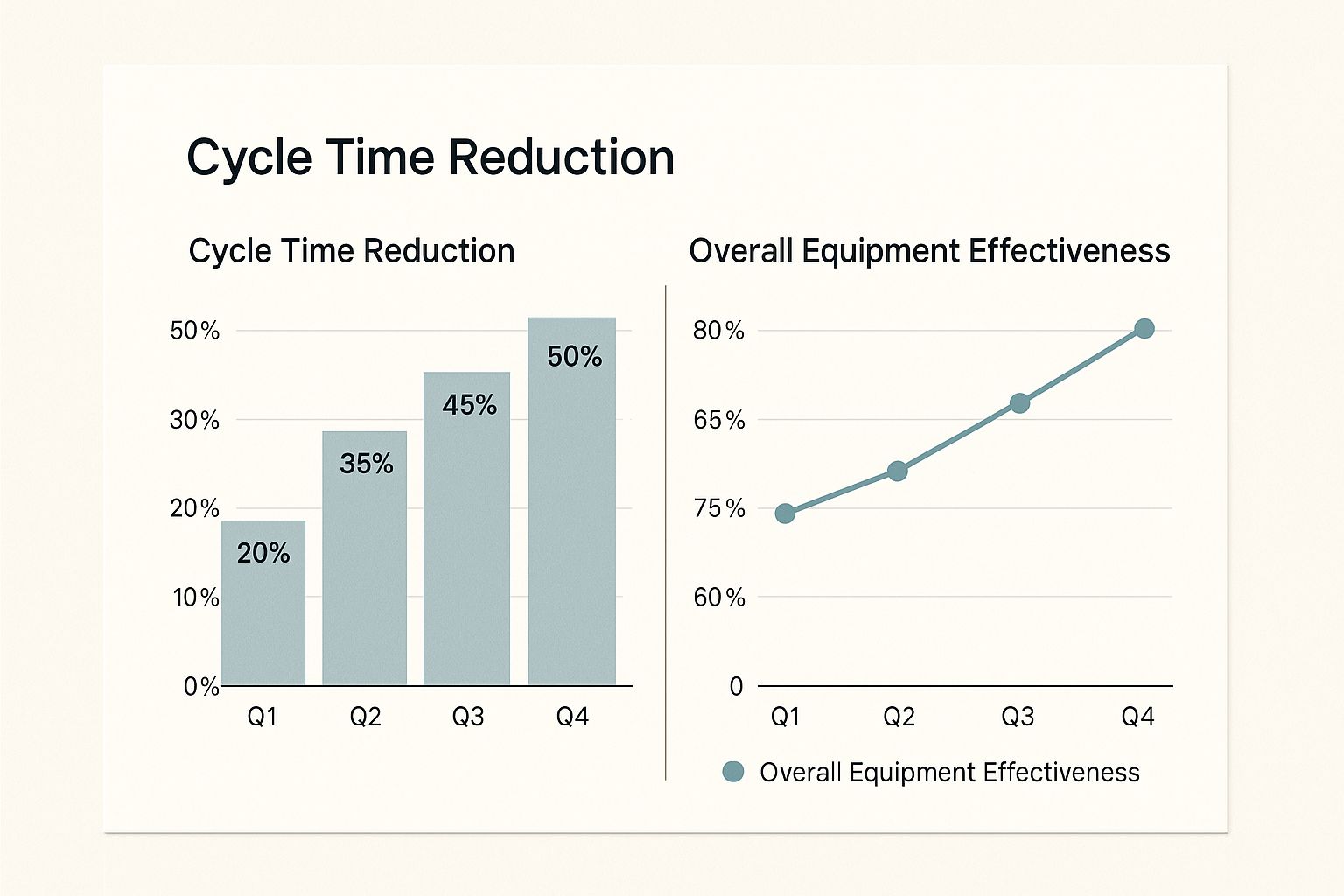Boosting operational efficiency isn't just a fancy business school term for "working faster." It's about getting rid of all the little snags and hang-ups that slow your entire operation to a crawl. For any company with technicians in the field, this means finally ditching those clunky, manual processes for smarter, more connected ways of working. The goal is to save time, slash errors, and let your skilled techs focus on the actual job, not the paperwork.
The Hidden Costs of Old-School Workflows
Let’s be real for a moment. The old way of doing things is costing you a lot more than you think. All those minor daily headaches—trying to decode a tech's chicken-scratch handwriting or playing detective to find missing job details—they add up. They create a ripple effect of hidden costs that quietly drag down your entire business.
A Familiar Story of Operational Drag
Picture a typical plumbing crew. A technician wraps up a complicated boiler repair, jots down some notes on a crumpled carbon-copy invoice, and drops it in the office dropbox at the end of a grueling day. The next morning, your office admin can’t make out half of what’s written. They have to call the technician, who's already deep into another job and struggling to recall the exact parts he used 16 hours ago.
Sound familiar? This one, tiny breakdown triggers a whole chain of problems:
- Delayed Billing: The invoice sits in limbo until the details are sorted out, directly impacting your cash flow.
- Costly Errors: The wrong parts get billed, leading to an angry customer, a corrected invoice, and a hit to your reputation.
- Wasted Payroll: Your technician and your admin are both burning paid hours clarifying things that should have been captured correctly on site.
This isn't just about being inefficient. It's about the lost opportunities and the competitive edge you surrender by clinging to outdated methods. When your team is stuck in a web of manual tasks, they can't be nimble or focus on growing the business.
How We Think About Efficiency Has Changed
In the past, operational efficiency was all about the factory floor—squeezing more out of the production line while cutting material and labor costs. It was a race to measure performance against potential, a concept that was crucial for industrial-era survival.
But for today's field service businesses, that model doesn't quite fit. The focus has shifted from the assembly line to the flow of information. The real bottleneck isn't a machine; it's the paperwork and manual data entry that bridges the gap between your team in the field and your team in the office. To see just how much this impacts a business, you can explore some effective document workflow management strategies. These outdated workflows are the true source of operational drag, actively holding your business back from what it could be.
Why Manual Data Entry Is Holding Your Business Back

The daily grind of manual data entry is more than just a time-waster; it’s a silent killer of your business’s momentum. Think about it. Every minute a technician spends trying to recall job details from hours ago, or an admin squints at barely legible handwritten notes, is a moment you can never get back. Productivity, data integrity, and even revenue are all leaking away.
This isn't just about a stack of paperwork. It's about the compounding effect these "small" daily frustrations have on your entire operation. Relying on manual data entry is one of the biggest roadblocks to improving operational efficiency. The reality is, while over 90% of executives see the need for better systems, most are stuck just talking about it, never moving past the planning phase.
These seemingly minor holdups have a nasty habit of snowballing into serious business problems.
The Real Price Tag on Inefficient Data Capture
Let's talk about the hard costs. A single technician might spend anywhere from 30 to 60 minutes at the end of their day just trying to organize notes and fill out paperwork. If you have a team of ten techs, you're suddenly losing up to ten hours of skilled labor to administrative busywork. Every. Single. Day. That’s essentially a full-time salary you're paying just for people to play catch-up.
This time-suck triggers a chain reaction that hurts the entire business:
- Lost Revenue: When data entry is slow, invoicing is slow. This messes with your cash flow and can push payments back by weeks.
- Wasted Productivity: You hire technicians for their technical skills, not their typing speed. Every moment they're wrestling with paperwork is a moment they aren't doing billable work.
- Unhappy Customers: Sloppy, inaccurate notes can lead to wrong invoices or botched follow-up jobs. This kills customer trust and creates disputes that eat up even more of your team's valuable time.
The heart of the issue is this: manual data entry creates a fragile, unreliable link between your field team and the office. It introduces countless failure points, from the initial on-site note to the final invoice, turning what should be a valuable asset—your data—into a ticking time bomb.
Measuring the Damage
The consequences aren't just a feeling; they're measurable. Inefficient workflows don't just feel slow—they actively shrink your capacity to serve more customers and make more money. When your team is stuck in the mud of manual processes, they can't jump on new opportunities or focus on the high-value tasks that actually grow the business.
This is where the argument for a change becomes crystal clear. Moving away from manual entry isn't just a nice-to-have upgrade; it's a strategic move for survival and growth. A great next step is to look into the top document automation software for streamlined workflows to see how you can cut down on these manual tasks. The ultimate goal is to create a system where information flows freely, empowering your team instead of holding them back.
How AI Is Actually Changing Field Service Work

If you've ever dealt with the daily grind of manual data entry, you know how draining it is. Moving to an AI-driven workflow is like stepping out of the chaos and into clarity. Artificial intelligence isn't some far-off idea anymore; it's a real tool that’s changing how field service teams operate by tackling one of the biggest bottlenecks: capturing and organizing job notes.
The real beauty of this approach is its simplicity. Think of an AI assistant like Nora, which works through an app your team already has on their phones, like WhatsApp. Technicians can send voice notes, photos, or quick texts straight from the job site without missing a beat. The AI takes over from there, transcribing what they said, tagging photos, and dropping everything into a clean, structured job log. This isn't just about saving time—it’s about making your data work for you.
Before and After: A Look at Field Notes
Let's get real for a second. We've all seen the old way. A technician wraps up a long day and then has to spend an hour trying to make sense of their own messy handwriting, recalling specific parts and measurements. It’s tedious, full of potential errors, and a direct hit to your bottom line.
Now, let's look at the new way. The same technician finishes a job, sends a 30-second voice note to Nora with all the details, and is already on the way to the next site. That's it. Their part of the admin is done. The time they spend on daily paperwork can drop from over an hour to less than ten minutes.
The real change is taking scattered, messy field notes and turning them into a searchable, strategic asset. What used to be a headache is now a goldmine of information for invoicing, tracking inventory, reviewing customer history, and even training new hires.
This isn't just a niche trend. By 2025, it's expected that 72% of companies will be using AI in at least one part of their operations. In fact, industrial factories that have adopted AI have already cut costs by as much as 32%, which shows just how much potential there is for improving operational efficiency. You can read more about how AI is reshaping different industries on jusdaglobal.com. It’s a move that makes work faster and far more accurate.
It's Not Just About Speed—It's About Better Data
Saving time is great, but the biggest win from using AI in field service is the massive improvement in the quality of your information.
- Spot-On Accuracy: Voice-to-text AI gets rid of illegible notes and forgotten details. Every part number, measurement, and customer comment is captured perfectly.
- A Rich, Searchable History: Trying to remember what happened at a specific site six months ago? Instead of digging through a pile of paperwork, you can just search a keyword and get the complete job log in seconds—notes, photos, and all.
- Spotting Problems Before They Start: AI can pick up on recurring issues across different job sites. This helps you identify trends in equipment failure or find opportunities for preventative maintenance before a small issue becomes a major crisis.
In the end, AI gives your team back their most valuable resource: time. Technicians can focus on what they're good at—solving customer problems—while your office gets the accurate, real-time data it needs to run the business smoothly. It’s a genuine upgrade for your entire operation.
Your Practical Roadmap to Bringing AI into Your Workflow

Jumping into AI doesn't have to be some massive, intimidating overhaul. From what I’ve seen, the most successful companies don’t start with a grand, theoretical strategy. They start with a practical plan, looking at what’s right in front of them to find the specific spots where AI can make an immediate, tangible impact.
The best place to begin is with a frank look at how you operate right now. Where are the real bottlenecks? Where does the day grind to a halt? Maybe your technicians are spending an hour every evening writing up notes they can barely remember. Or perhaps your office team is constantly on the phone, chasing down job details just to get an invoice out the door. Finding those specific pain points is the whole game.
First Things First: Audit Your Current Workflow
Before you even glance at a new piece of software, you need to map out your process. I mean really map it out. Follow a single job from the moment the phone rings to the second the final payment clears.
Pay close attention to every handoff—every point where information moves from one person to another. This is almost always where you'll find the biggest opportunities for improving operational efficiency.
- How does a tech get their marching orders? Is it a clear, digital dispatch or a hurried phone call?
- What are they logging on-site? What’s required, and how are they actually capturing that info? Scraps of paper? A clunky app?
- What’s the end-of-day routine? How do notes, photos, and timesheets get back to the office?
- How does that field data become an invoice? Does someone have to manually re-type everything?
This simple exercise will shine a spotlight on the drag. It could be deciphering sloppy handwriting or the endless back-and-forth calls to clarify what parts were used. These are the exact problems you want AI to fix.
Insider Tip: I’ve seen this mistake a hundred times: don't just automate a broken process. If your current workflow is a tangled mess, adding technology just creates a faster mess. Use this audit as an opportunity to simplify and clean up your steps before you introduce any new tools.
Pick the Right Tool and Run a Small-Scale Test
Once you’ve identified your core problems, you can start looking for the right solution. The key is to find something that your team will actually use. The learning curve has to be minimal. An AI assistant like Nora, for example, works through familiar apps like WhatsApp, which completely removes the friction of adopting a new system. Technicians can just send voice notes and photos like they already do.
The trick is to start small. Never, ever roll out a new system to your entire company on day one. Pick a small, motivated group—even just one or two of your most tech-savvy technicians—and run a pilot program.
This does two brilliant things for you:
- It proves the concept. You can collect hard data on time saved and errors reduced on a manageable scale.
- It creates champions. The techs in that pilot group become your best advocates. They'll be the ones showing everyone else how easy and effective it is.
Get Your Team Involved from the Get-Go
Honestly, the biggest mistake you can make is springing a new tool on your team without their input. Your technicians are on the front lines. They know the workarounds, the frustrations, and what will actually make their day easier. You have to ask for their feedback from the very beginning.
This isn't just about being nice; it's about being smart. The move toward automation is huge right now, with businesses everywhere using low-code or no-code tools to eliminate manual data entry. These tools are fantastic for consistency and accuracy, but they only work if they’re built on a solid foundation. If you want to see how this is playing out across the board, you can explore the latest operational efficiency trends.
The bottom line is simple: involve your team. Make sure the solution you choose solves their real-world problems, not just the ones you see from the office.
Seeing the Real-World Impact of AI
Theory is one thing, but seeing the results in the real world is where the rubber meets the road. The shift from a manual workflow to one driven by AI isn't just a small tweak—it's a complete change in how your business functions. The true impact isn't just about saving a few minutes; it’s measured in tangible returns like hours reclaimed, errors wiped out, and a much healthier bottom line.
When you translate the daily grind into hard numbers, the business case for AI becomes impossible to ignore.
From Manual Logs to AI-Powered Insights
Making the switch from pen-and-paper logs or clunky mobile apps to a smooth AI assistant like Nora creates immediate value. When you automate the tedious, soul-crushing parts of the job, you unlock serious gains in both productivity and accuracy—the two pillars of improving operational efficiency.
Let's look at some real-world examples. I recently worked with a plumbing company that managed to slash their invoice disputes by nearly 90% in just three months. How? The AI captured every single detail from the technician's voice notes with perfect accuracy. No more back-and-forth over parts used or hours worked. The notes were clear, time-stamped, and tied directly to the job file.
Another great story comes from an HVAC service I know. They boosted their first-time fix rate by 15%. The secret was having a much more accurate equipment history at their fingertips. Before a technician even headed to a job, they could review past notes and photos logged through the AI, meaning they knew exactly what they were walking into.
The real goal here isn't just about doing the same old tasks faster. It's about capturing better information so you can work smarter, get ahead of problems, and deliver a consistently amazing level of service.
The data speaks for itself. As AI becomes a regular part of the workflow, you see a steady drop in job cycle times and a clear rise in overall equipment effectiveness.

As you can see, sticking with an AI-driven system leads to powerful, compounding improvements quarter after quarter.
The Numbers Don't Lie: ROI You Can Take to the Bank
Let’s get down to brass tacks and see what this looks like for a typical field service team. This isn't theoretical—it’s about the real return on your investment.
To make this crystal clear, I've put together a table comparing the old way of doing things with the new AI-powered approach. The numbers are based on what I’ve seen with teams making this transition.
Manual vs. AI-Driven Note Logging: A Comparison
The table really highlights the difference. You're not just saving a bit of time; you're fundamentally changing how efficiently your entire operation runs. It's a direct path to a more resilient, profitable, and competitive business.
By eliminating the friction from your daily operations, you give your team the freedom to focus on what they do best: delivering fantastic work and growing the company.
Your Questions About AI in Operations Answered
https://www.youtube.com/embed/UpE1UyDElaE
Jumping into new technology always comes with a few questions, and that’s perfectly normal. When that technology touches the core of your daily operations, you need clear, honest answers. Let's walk through some of the most common concerns we hear from teams thinking about bringing AI into their workflows.
A lot of managers I talk to are worried that a new system will be a headache for their field crews to learn. The truth is, modern AI tools like Nora are built to be incredibly simple. They slide right into the apps your technicians are already using every single day, like WhatsApp.
If your team can send a text message or a quick voice note, they already have all the skills they need. There's no new, clunky software to install on their phones and no complicated dashboard to figure out. This easy, almost invisible integration is what makes adoption so successful and gets you to improved operational efficiency that much faster.
Is My Company Data Secure?
This is a big one, and it should be. With sensitive job details and customer information on the line, data security is non-negotiable. It's a valid concern, and one that professional AI platforms take very seriously.
Systems like Nora are built with security as a foundation. All your data—from voice notes to job-site photos—is protected with end-to-end encryption. This happens both while the information is in transit and when it's being stored.
Think of it this way: your information is scrambled and completely unreadable to anyone who isn't supposed to see it. These platforms follow strict privacy standards, keeping your operational data just as confidential and secure as it is in any other professional business software you use.
What Is the Actual Return on Investment?
Figuring out the real ROI is about looking at what you gain versus what you spend. It goes beyond the subscription price—it’s about the massive value you get back from reclaimed time and fewer costly mistakes.
Here's a quick way to ballpark your ROI: Figure out how much time your techs spend on manual paperwork each day. Now, multiply that by your average hourly labor cost. For a team of 10 techs who each spend 45 minutes a day on notes, you’re looking at over 37 hours of skilled labor recovered every single week.
That number alone usually makes the financial benefit obvious and immediate. And that's before you even factor in things like fewer billing disputes and getting your invoices out the door faster.
Will This Replace My Admin Staff?
We get this question all the time, and the answer is a firm no. AI isn't here to replace your fantastic administrative team; it’s here to make their jobs better.
It takes the tedious, low-impact work off their plate—things like chasing technicians for job details or trying to read messy handwriting.
Instead of spending their day as data-entry clerks, your office staff can finally focus on what people are best at: high-quality customer communication, smart scheduling, financial oversight, and strategic planning. The AI handles the grunt work of collecting data, freeing up your human team to use their expertise on activities that actually grow the business.
Ready to stop chasing paperwork and start focusing on growth? See how Nora can transform your field operations with a quick, no-obligation demo. Discover Nora's AI power here.



